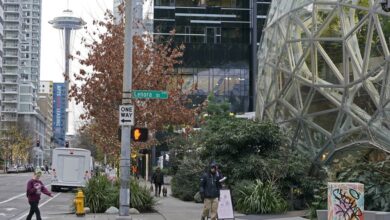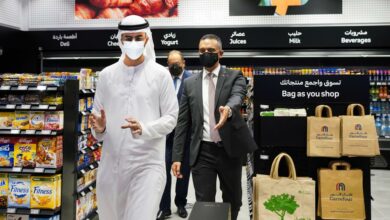One would imagine the tacky clothes displayed in the shop windows on Talaat Harb Street to be affordable, considering the obvious bad quality of the garments on show and their delirious mix of colors.
The sexy tops, for example, covered with splashes of glitter that can only be worn with a tight-fitting lycra turtleneck (for modesty), or the “princess kitsch” dress, preferably in gold with a huge diamond sewn onto the front, are only appetizers for the marvels that can be discovered while window-shopping in downtown Cairo.
But if you pay closer attention to the price tags dangling from the garments on sale, you are likely to feel bewildered. And for those in the know, there is simply no need to spend LE60 to LE90 for a psychedelic t-shirt “a la mode égyptienne,” when great quality and brands that actually ring a bell are only a stone’s throw away and available at an unbeatable price in Bulaq, one of the oldest northern quarters of Cairo.
The neighbourhood’s appellation is either a transformation of the French “beau lac” (beautiful lake), or derived from the ancient Egyptian word for “anchor,” which is also plausible as Boulaq was a major commercial port under the Mamaluk reign.
Today, the bling-bling motorboats screaming “Al 3enab” lined up along the corniche are the only traces of Bulaq’s past maritime glory.
The bustling neighbourhood, which combines old buildings blackened with encrusted layers of fumes, and modern-concrete architecture like the home of the Ministry of Foreign Affairs, is a vibrant commercial area, rocked by the incessant and deafening noise of traffic.
But Boulaq’s “raison d’être” lies on its sidewalk, crammed with racks bending under the weight of leather-jackets, velvet pants and wool sweaters by the thousand.
Under the bridge leading to Zamalek, the shops are crammed in and each uses a sizable portion of the sidewalk to pack their rails, forcing pedestrians to skilfully dodge a hesitant customer here, a hunk of meat hanging from a butcher’s hook there, or simply a big puddle of dirty water.
The magic of Bulaq also lies in its apparent disinterest in brands, which makes it possible for a brand-new Ralph Lauren polo to be pressed against a KFC T-shirt without surprising anyone. Also, only in Bulaq can a basic winter fleecy jacket cost the same price as a fluffy 100% cashmere sweater – on average a mere LE25.
The reason for this obvious lack of interest has to do with Port Said. In fact, most of the clothes imported from Europe and the States transit in Port Said where they are bought in blocks of 100 items before landing in Bulaq.
Mahmoud is the owner of a shop that specializes in jeans. The blue denim fabric is all over the place, folded in neat piles, hanging from the walls, and lined up on the racks outside. He explains that “the clothes come from the West, and most of the second-hand ones were given to charities before being shipped to Port Said.”
A quick perusal of the surrounding racks, sprouting Italian, English, French and German brands, confirms Mahmoud’s words. He also sells a lot of brand new jeans.
Mahmoud mentions a German company called “Only,” based in 6th of October City, that specializes in manufacturing jeans. Part of its production is exported to Europe, while the rest is sold in regular shops in Egypt for a price three to four times higher than the ones sold in Bulaq, which have flaws and have failed the quality control test.
“To give you an example, regular “Only” jeans are sold for LE180 downtown, but in Bulaq the same jeans with an unnoticeable fault can be bought for LE35,” he says, stretching some fabric to show its quality.
A stroll through Bulaq also gives potential customers an idea of how alert shop owners are, especially when a very recognizable pick-up truck with “Police” emblazoned on its sides enters the area.
It is better not to be immersed in a sea of racks when that happens, for they are all vigorously pushed back into the shops while the young police officers grin at the state of panic they have created.
Mohamed, a shop owner who sells a vast array of large-size winter coats and tremendously sexy lingerie, has just pulled his racks back inside and his forehead is wet with effort. “The police are after us – not for selling the clothes,” he explains, panting. “What bothers them is that we block the passage with our racks, blocking pedestrians and cars,” he says, pointing at the vast area of Bulaq El Gedida Street.
Only two minutes have passed since the police left the area, and already thousands of racks have been rolled back into place, filling the space entirely with colourful silk pyjamas, series of sweat pants, thousands of galabeyas and copious business jackets.
A German woman at the corner of one rack is methodically reviewing the clothes, looking for her dream cashmere sweater. She recalls once hearing that the Hilton’s general manager shopped in Bulaq. “I have been living in Egypt for many years,” she says, while still scrutinizing the clothes in front of her, “and I have come to the conclusion that the best quality garments are to be found here,” she adds with a connoisseur’s smile.




